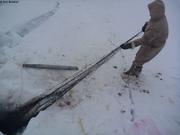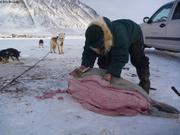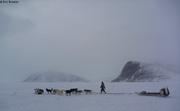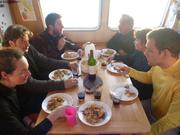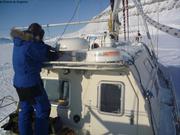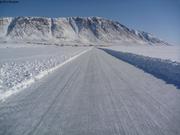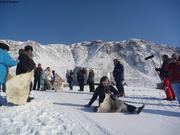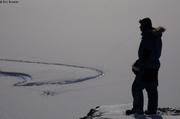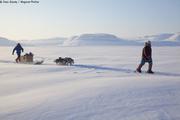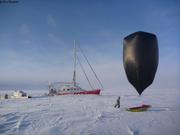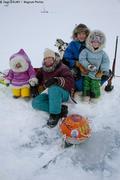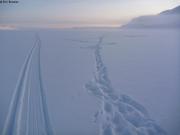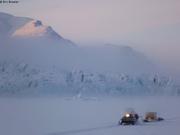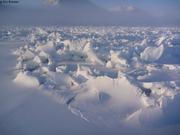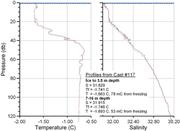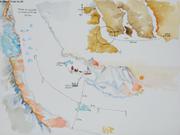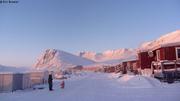Conditions idéales, aujourd'hui, pour enfin gravir la pyramide qui nous nargue
depuis notre arrivée, il y a exactement six mois. Lemmings, renards et lièvres
m'ont précédé. La vue est superbe. Décidément, nous avons choisi un très beau
site pour hiverner !
Demain, je retourne au village, où j'ai laissé France, Léonie et Aurore le
week-end dernier. La banquise est couverte de petites congères de neige,
depuis la dernière tempête, il faut maintenant près de trois heures pour
parcourir les 50km en motoneige. Bientôt, nous pourrons profiter de la piste
que les villageois vont tracer sur la banquise jusqu'à l'ancien village, de
l'autre côté du fjord Grise (10km). Pour cela, la mairie m'a demandé les
épaisseurs
Best conditions, today, to climb the pyramid which has been taunting us since
we arrived, exactly six months ago. Lemmings, foxes and hares got there first.
The view from the summit is great. We really found a nice spot to overwinter!
Tomorrow, I'm going back to the village, where I left France, Léonie and
Aurore last week-end. Packice is now covered with snow drifts, since last
storm, and we need almost three hours to cover the 50km by snowmobile. Soon,
we will enjoy the ice road that will be made until the old village, on the
other side of Grise Fiord (10km). For that, the hamlet asked me about the
thickness
data;
a minimum of 120cm is needed.
France is resting, getting rid of dizziness; she is also going to sewing and
kamiks (skin boots) lessons. Léonie is happy going to school and playing with
friends. Aurore is pampered by Liza, and also the nurse who had to treat her
after a nice stunt!
Jean Gaumy left this morning, by Twin Otter, after having integrated
discreetly with life in the village for a week. Before that, his stay on board
"allowed him, according to a process carefully non scientific, to check the
inevitable limits between reality and fantasy" (from the guest book). We will
share soon on line some of his pictures!
Last Friday, a delicious feast was organised by Meeka, mayor of Grise Fiord,
to celebrate the end of nutrition course. Tomorrow will start Easter holidays
and games...
So, meanwhile, I'm alone on board. Nice weather, no wind, the silence is as
fascinating as evening lights. We wish this season would last. I watch a fox
passing on the shoreline, short and quick steps, always on his guard.
Temperatures are increasing slowly, and I even managed to take a coffee
outside (-15°C at lunch time)! While doing scientific routine measurements, I
met tracks from a female polar bear with her two young cubs, whose tracks are
not even bigger than dogs tracks. They might have come out from their den not
long ago. One night, I was waken up by little knocks, as if someone was at the
door... When I got up, I scared ravens that were eating our piece of muskox
meat on the front deck!
